Body length: 5–10 mm.
Eyes: eye interommatidial setaeseta:
a sclerotized hair-like projection of the cuticle
absent, eye deeply emarginateemarginate:
notched at the margin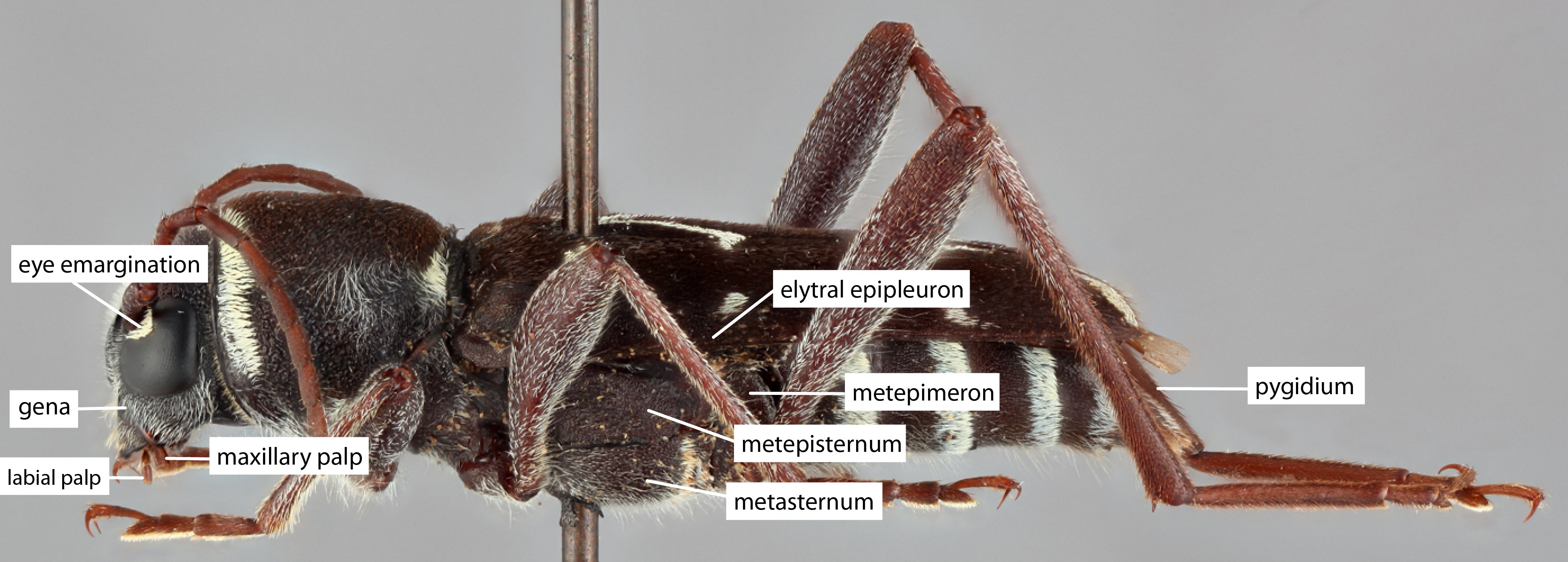 > half width, eye ommatidial density coarse.
> half width, eye ommatidial density coarse.
Antennaeantenna:
in larval and adult insects, paired segmented appendages, borne one on each side of the head, functioning as sense organs and bearing a large number of sensilla
: antennal length reaches between basebase:
the part of any appendage or structure that is nearest the body
and end of elytraelytron:
the leathery forewing of beetles, serving as a covering for the hind wings, commonly meeting opposite elytron in a straight line down the middle of the dorsum in repose
or reaching/surpassing end of body, antennal flagellar segments elongateelongate:
much longer than wide
, scapescape:
the first proximal segment of the antenna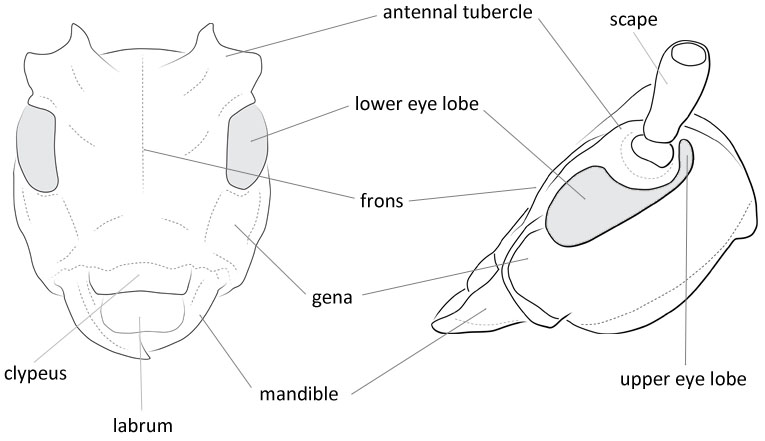 smooth/punctate at apexapex:
smooth/punctate at apexapex:
end of any structure distad to the base
, antennal segment 3 > scapescape:
the first proximal segment of the antenna .
.
Pronotumpronotum:
the upper and dorsal part of the prothorax
: pronotumpronotum:
the upper and dorsal part of the prothorax
shape transversetransverse:
broader than long
, pronotumpronotum:
the upper and dorsal part of the prothorax
lateral armature acute spinespine:
a protuberance with an acute (sharp) distal end
.
Prosternum: prosternal processprosternal process:
a posterior extension of the prosternum between the coxae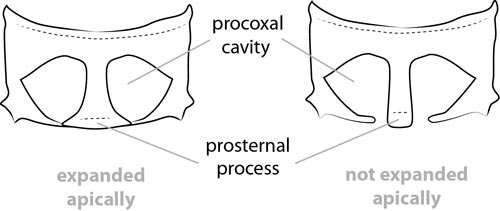 dilated at apexapex:
dilated at apexapex:
end of any structure distad to the base
, procoxal cavities closed posteriorly.
Elytraelytron:
the leathery forewing of beetles, serving as a covering for the hind wings, commonly meeting opposite elytron in a straight line down the middle of the dorsum in repose
: elytral length reaching or close to end of abdomen, elytral apicesapex:
end of any structure distad to the base
rounded or truncatetruncate:
cut off squarely at the tip
, elytral color black, brown, or reddish, elytral color pattern present or absent.
Legs: visible tarsomerestarsomere:
subdivision or article of the tarsus, usually numbering from two to five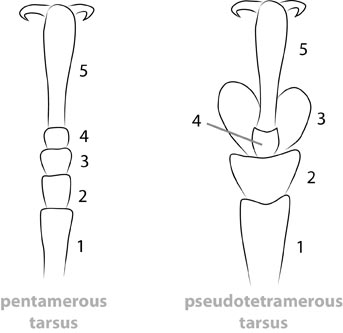 : 4, femora clavateclavate:
: 4, femora clavateclavate:
thickening gradually toward the tip
, rarely robust, protibial spursprotibial spur:
sclerotized spine(s) located at the distal tibia; can be single, double, or absent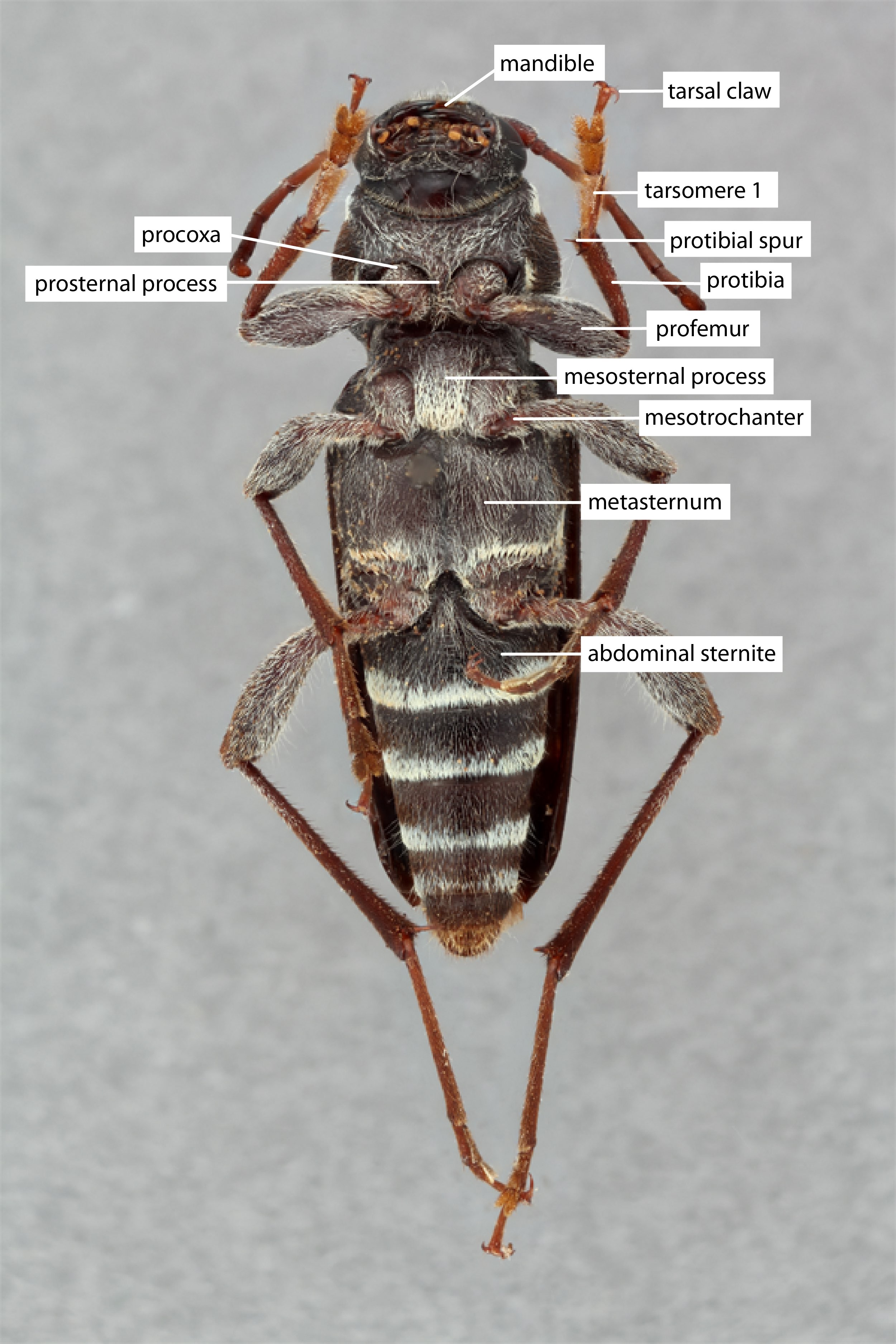 : 2, tarsal clawstarsal claw:
: 2, tarsal clawstarsal claw:
usually paired claws of the pretarsus, at the distal end of the leg simple.
simple.
Form small, cylindricalcylindrical:
shaped like a cylinder, parallel sided
. Head large, quadrate: front short, transversetransverse:
broader than long
; palpi slender, unequal, apical segments pointed; eyes deeply emarginateemarginate:
notched at the margin , coarsely faceted; lower lobes longer than genaegena:
, coarsely faceted; lower lobes longer than genaegena:
the part of the cranium on each side below the eye ; antennal tubercles flattened, small, widely separated; antennaeantenna:
; antennal tubercles flattened, small, widely separated; antennaeantenna:
in larval and adult insects, paired segmented appendages, borne one on each side of the head, functioning as sense organs and bearing a large number of sensilla
slender, fringed with long hairs beneath, basal segments also fringed dorsally, scapescape:
the first proximal segment of the antenna cylindrical, third segment longer than scapescape:
cylindrical, third segment longer than scapescape:
the first proximal segment of the antenna , fourth a little shorter than third, fifth and following segments about one-half as long as fourth. Pronotumpronotum:
, fourth a little shorter than third, fifth and following segments about one-half as long as fourth. Pronotumpronotum:
the upper and dorsal part of the prothorax
cylindrical, transversetransverse:
broader than long
, sides with distinct acute tubercles or small calluses; disk convex; prosternum short, intercoxal process arcuatearcuate:
arched or bow-like
; mesosternal processmesosternal process:
a prolongation of the mesosternum extending between the mesocoxae
abruptly declivous in front. Elytraelytron:
the leathery forewing of beetles, serving as a covering for the hind wings, commonly meeting opposite elytron in a straight line down the middle of the dorsum in repose
parallel, sub cylindricalcylindrical:
shaped like a cylinder, parallel sided
; wings present; apicesapex:
end of any structure distad to the base
rounded. Legs short; femora moderately clavateclavate:
thickening gradually toward the tip
; tarsitarsus:
the leg segment distal to the apex of the tibia, bearing the pretarsus; consists of one to five tarsomeres (including pretarsus)
short, third segment cleft to basebase:
the part of any appendage or structure that is nearest the body
. Abdomen normally segmented (Linsley and Chemsak 1984Linsley and Chemsak 1984:
Linsley EG and Chemsak JA. 1984. The Cerambycidae of North America. Part VII, No. 1. Taxonomy and Classification of the Subfamily Lamiinae, Tribes Parmenini Through Acanthoderini. University of California Press, Berkeley and Los Angeles. 258 pp.).
Can be distinguished from Pogonocherus by fourth antennal segment shorter than third and not incurved and elytral apicesapex:
end of any structure distad to the base
always rounded.
Nearctic, Neotropical
various broadleaf trees; Pinus, Picea, Cedrus
62 species. E. tomentosus known from conifers. Larvae burrow under the bark. The following season they enter the wood to form a U-shaped pupal cell lying in the same plane as the grain of the wood. Both ends of this cell are plugged with fibrous chips.
Phidola Chevrolat, 1862
Eriopsilus Bates, 1866
Eupogonius LeConte, 1852